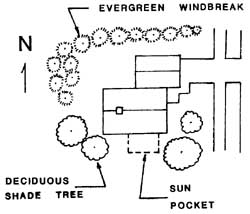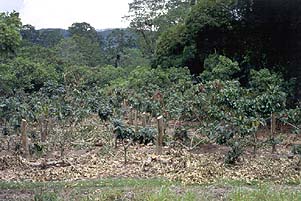Trees, Energy and People(Additional information to a lesson hold by Dr. Ernst Kürsten at Fachhochschule Eberswalde (University of Applied Sciences), International Forest Ecosystem Management on June 18, 2001) (The transparencies of the lesson you can download as pdf-file (294 kByte).) Urban ForestryTraditionally trees in the gardens are used all over the world for the production of fruits and fuelwood, but also as windbreaks and umbrellas for the homes. This physical functions as very much stressed actually e.g. in the United Kingdom and the United States because of the need of energy savings to reduce carbon dioxide emissions. Carefully positioned trees can save up to 25% of a household s energy consumption for Picture: Suggested locations for windbreak, shade trees and sun pockets. (from Walker, L. 1992) A "Smart Planting Guide" with a lot of information on this was prepared by TreePeople for the City of Los Angeles Department of Water and Power (DWP) and can be downloaded as pdf-file. TreePeople and DWP have joined in a partnership to reduce carbon dioxide emissions in the Los Angeles area by the smart planting of trees around homes and through extensive tree plantings in nearby mountains. - Scientific publications on urban forestry is being provided online by the University of Minnesota Forestry Library. There are also lists of organizations, companies, electronic journals etc. mainly in the U.S.. The European Forum on Urban Forestry in 2001 had the topic "Partnership led regeneration - the role of urban and community forests" (see: IUFRO Unit 6.14.00 Urban forestry) Agroforestryis one of the new fields where foresters have to do with questions of energy and needs of people. Definitions and general information on this are being provided by The International Centre for Research in Agroforestry (ICRAF) and under http://www.agroforestry.net/. Here some details shall be explained: 1. "Growing agricultural crops together with trees allows to reduce the input of fertilizer for different reasons: Indirectly a reduction of CO2-emissions is the consequence of all these effects since the production of fertilizers is an energy-intensive process. According to Mittal et al. (1992) by alley cropping 20 kg N.ha-1.yr-1 can be saved. Assuming an energy-input of 60 MJ.kg-1 for N-fertilizers (Zweier, 1985) and C-emissions of 0.02 kg C.MJ-1 (see Burschel et al. 1993), the annual reduction in emissions would be 0.024 tC.ha-1. If it is possible to save all 80 kg of N-fertilizers normally applied, this value increases to 0.1 tC.ha-1.yr-1." (Kürsten and Burschel, 1993) 2. During a pratical experiences in Turkey and Greece I once learned something about the problems occuring when foresters simply think that forests have to be planted: Herdsmen regularly set the afforestion on fire, because it was their former pasture land. In New Zealand today its well known that grazing with sheep for the first few years of a crop rotation can provide benefits in terms of reduced hindrance for silviculture and reduced fire risk. In situations where parts of farms have been planted by farmers, or in association with farmers, then it is likely that understorey grazing will be an integral part of farm management. 3. Living fences are a traditional agroforestry system in Central America for farm or pasture delimination. Living fences are widely used now in a wide range of ecological situations, from very dry to rain forest conditions. Suitable plant materials are available for almost all ecological conditions. 4. Shelterbelts are a widespread and proven means to increase the agricultural production in spite of its use of land. This is especially true for regions with sandy soils and dry summers. Woody windbreaks may not only reduce irrigation costs in agriculture but also energy consumption of cars if properly arranged along motorways. This could be an interesting topic for quantifiing investigations. A quantiative overwiew on all the possible effects in term of CO2-mitigation is given in my publication: KÜRSTEN, E. 1999/2000. Fuelwood production in agroforestry systems for sustainable land use and CO2-mitigation.In: Forests in Focus, Proceedings Forum "Forests and Energy" 17 - 21 January 1998, NNA Reports, Vol. 12, Special Issue 1, 1999, 141-143 + Ecological Engineering 16 (1001), 69-72; Download pdf-file (69 KByte) Wood use and climate changeTo use wood as a raw material instead of steel or concrete in many cases leads to a distinct reduction of CO2-Emissions from fossil fuel. Today the energy necessary for the processing of lumber completely comes from wood residues. I this cases the products can be considered as "CO2-neutral". The production of wood as important CO2-reducing "side effect" actually is gaining more and more attention. In the actual (June-)edition von "Climatic Chance" Nabuurs and Sikkema write."Accounting harvested wood products and their trade as an integral part of the carbon cycle of a managed forest is a challenging task. Nevertheless, an appropriate way is especially needed now that harvested wood products may be included in Article 3.4 of the Kyoto Protocol. The adoption of a method for accounting for these flows in the IPCC guidelines may have implications for the trade of wood products and thus on global forest management." All the forestry and wood use effects that mitigate the increase of the CO2 concentration in the earth's atmosphere are calculated. by GORCAM (Graz / Oak Ridge Carbon Accounting Model). It is a spreadsheet model that has been developed to calculate the net fluxes of carbon to and from the atmosphere associated with such strategies. The model considers
A basic publication on this is: BURSCHEL, P., KÜRSTEN, E., LARSON, B.C. 1993. Die Rolle von Wald und Forstwirtschaft im Kohlenstoffhaushalt - Eine Betrachtung für die Bundesrepublik Deutschland. Forstl. Forschungsberichte München, Nr. 126, 135 S. (with english summary)
Forestry and PeopleToday foresters have to change their tradional minds. Historically their role in many countries was and often still is to be the policemen defending "their" forests. The world now needs consultants that identify the peoples necassaries and help them to satisfy them by growing trees. There are many examples, e.g. in Turkey, where newly planted forests were set on fire by herdsmen who were shut out of their former pasture grounds by afforestations. Here agroforestry systems - as mentioned above - should better be developed in close cooperation between foresters and herdsmen. In Greece forests are often burned down, because it is forbidden to build houses there. Here a better land use planing and changes in legislation possibly would help. Foresters need to take part actively in this processes. In the United States forest fragmentation is the actual top theme of forest policy:
This trends naturally are impending for an efficient and sustainable use of the forest ressources. Moreover in urbanized areas this land now is becoming more and more sold for estate development for people who are willing to live closer to nature.
Short reports on the main results of the Third international Conference on Private Forests and of the "Großer Europäischer Waldbauerntag in Hannover am 29. September 2000" were written by the author of this site for the Holz-Zentralblatt (pp. 1699 and 1771; in german!) and can be downloaded as pdf-files. Funds for tree plantings and afforestationsA very active organization with partners all over the world is "American Forests". Their mission is to help people to improve the environment with trees and forests. In Germany PRIMAKLIMA weltweit e.V. is financing and promoting afforestation and forest conservation projects all over the world as an important contribution to revent global climate change. The author was working as a secretry general for PRIMA KLIMA 1993-1994. He is also a member of the "Freundeskreis Tambacounda" in Hannover. This an organization promoting the culture and the development of Senegal and the surrounding countries in Africa. Trees play an important role in this hot and dry area to make the peoples life more pleasant. Fuelwood also is an essential product from trees in the cities and the countryside.
"A conclusion of this study is that there appears to be substantial private sector financial resources available for projects that meet the risk/return profiles that the market demands. At the same time, there appears to be a large number of potential projects, a proportion of which have the potential to meet market requirements. The observed low level of investments in SFM, therefore, illustrates a clear case of market failure, where something currently prevents capital from flowing. We propose, therefore, that there is a strong need to link investors and investment and facilitating deals. It appears as well that innovative structuring and financing approaches may need to be used in order to remove some of the barriers Finally it shall be mentioned that the Shell company is investing in forestry as part of a future based on solar energy. Shell Forestry maintains a planted area of around 140 000 hectares - roughly the size of greater London. It has plantation projects in Argentina, Chile, Paraguay, Uruguay, the République du Congo and New Zealand. Recently Shell Forestry has been awarded Forest Stewardship Council (FSC) certification for its 159,000 hectares of forests in Latin America. Further information: Dr.Ernst Kürsten, E-Mail: e.kuersten@t-online.de |
 heating and cooling. Computer models devised by the
heating and cooling. Computer models devised by the  mulching they are recycled back to the upper soil horizons.
mulching they are recycled back to the upper soil horizons.

 At the Third International Conference on Private Forests in Hannover (Germany) on Sept. 30th 2000 Laurence D. Wiseman (left), President of the American Forest Foundation, explained: "Forest owners have many opportunities to sell their property, often for prices that far exceed its value as timberland. But as forestland begins to disappear, the reasons people moved closer to the woods begin to disappear as well. So our new neighbors have as much incentive as we do to help forest owners keep their forests green. They can be our allies as we seek to find ways to compensate landowners for the socail benefits they provide: carbon sequestration, recreation, green space, watershed health."
At the Third International Conference on Private Forests in Hannover (Germany) on Sept. 30th 2000 Laurence D. Wiseman (left), President of the American Forest Foundation, explained: "Forest owners have many opportunities to sell their property, often for prices that far exceed its value as timberland. But as forestland begins to disappear, the reasons people moved closer to the woods begin to disappear as well. So our new neighbors have as much incentive as we do to help forest owners keep their forests green. They can be our allies as we seek to find ways to compensate landowners for the socail benefits they provide: carbon sequestration, recreation, green space, watershed health."